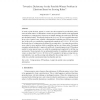920 search results - page 59 / 184 » Computing the Frequency of Partial Orders |
SLP
1993
13 years 11 months ago
1993
In this paper we describe a method of programspecialisation and give an extended example of its application to specialisation of a refutation proof procedure for rst order logic. ...
PAAMS
2010
Springer
14 years 2 months ago
2010
Springer
In this paper, we introduce a new heuristic search algorithm based on mean values for anytime planning, called MHSP. It consists in associating the principles of UCT, a bandit-base...
JCSS
2010
13 years 8 months ago
2010
To make a joint decision, agents (or voters) are often required to provide their preferences as linear orders. To determine a winner, the given linear orders can be aggregated acc...
DCC
2003
IEEE
14 years 9 months ago
2003
IEEE
The Prediction by Partial Matching (PPM) algorithm uses a cumulative frequency count of input symbols in different contexts to estimate their probability distribution. Excellent c...
IJLT
2010
13 years 8 months ago
2010
: Ubiquitous computing could help the organisation and the mediation of social interactions wherever and whenever these situations might occur. Using those technologies enables the...

